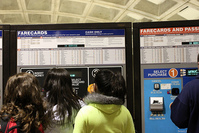Topic of the week: Is the Metro fare hike fair?

Photo by Oran Viriyincy on Flickr.
The WMATA Board yesterday approved a fare increase, which will be effective July 1. Are the fare hikes fair?
Metrorail fares will increase 3%, on average, and most Metrobus routes will now cost $1.75, no matter if you pay with cash or SmarTrip. Today, the buses cost $1.60 with SmarTrip, $1.80 cash. Parking rates at Metro lots will go up 10¢, except at some Prince George’s County lots, which will cost 60¢ more.
Are the fare increases too great? Did WMATA make the right call with the specifics of the fare hike? Our contributors weigh in below. What do you think? Post your thoughts in the comments.
Michael Perkins: WMATA missed another opportunity to make their parking pricing make sense. They raise the rates universally by only 10¢, and put an additional 50¢ on most lots in Prince George’s County, even though there’s already a large east/west divide in ridership, and the PG County lots are less crowded than other parking lots.
For the 2016 fare update, WMATA staff should do their homework and get ready to implement something similar to BART. BART staff are allowed to periodically review and adjust the parking rates in their parking lots based on demand.
For the cash fare on bus business, I think WMATA made the right call. The cash discount was causing a lot of people to load one trip’s worth on a SmarTrip card and then use it immediately just to get the SmarTrip discount.
Dan Malouff: Just to keep up with inflation since WMATA’s last fare hike in 2012, fares should rise between 2-3%. The Metrobus hike is a lot, but the Metrorail hike of 3% is not much more than inflation. But even buses are matching inflation over the long term. A DC Metrobus fare in 1975 was 40¢. Adjusted for inflation, that would be $1.75 today.
Ben Ross: I find it very disappointing that WMATA has paid for lesser fare increases by cutting funding for bus priority corridors. It is very hard to take long-range plans for expensive “bus rapid transit” seriously if the area isn’t willing to make modest investments in making its buses move more rapidly now.
Malcolm Johnstone: People are being priced out of using the subway and, now, the bus. Metro is too expensive — nowhere else in North America can you pay $10 round trip just for subway ride.
Malcolm Kenton: WMATA still needs to institute some form of daily, weekly and monthly pass that covers both bus and Metrorail. Nearly every other big city transit agency that operates both bus and rail offers passes that cover both. If a 7-day “short trip” rail pass is $36 and a 7-day bus pass is $17.50, perhaps a 7-day “short-trip” rail pass that also includes unlimited bus travel could be $50.00. Similarly, a 28-day rail-plus-bus pass could be $260.00.
It’s interesting to note that the deal remains in place that allows those with current weekly or monthly MARC train tickets to ride local buses in both the DC and Baltimore regions, as well as the Baltimore subway and light rail, at no additional cost. At $175.00, a MARC monthly ticket between Baltimore and DC is a great bargain for those who also travel extensively within either metro area: the only other form of transit it doesn’t cover is Metrorail.
Can WMATA’s rationale for these hikes be tied directly to any change in federal funding, or to a change in any particular jurisdiction’s share of funding? Or simply to declining ridership and/or increasing costs?
Michael Perkins: Even better than that, the MTA sells a zone 1 bus pass that’s good on all WMATA services as well as service in Baltimore. The Transit Link Card is just a hair under $200 and is good for everything. It covers rail and bus. Unlimited everything, including zone one MTA commuter bus and all the MTA service in Baltimore too. I don’t know that there are any restrictions. Someone should try it.
The thing is on autopilot. I don’t think Metro staff or the board really look at it so it just goes up with inflation every year, even though the peak long distance rail fare has outpaced inflation for a decade.
Metro has some of the highest fares in North America. I think only the London Tube has higher fares in the world. On the other hand, the trains are bursting with people. The London Tube also has reasonable passes, unlike Metro, and a congestion charge.
Myles Smith: I was surprised how close Metrorail was to the actual per-rider cost, with taxpayers subsidizing the fares by only about 20%, was it? Metrobus was more heavily subsidized, something like 60% by taxpayers. And any discussion of it should compare these subsidies to those of public streets for private vehicles (a 100% subsidy).
Jim Titus: We should not have to revisit every policy question related to equitable burden sharing, simply to make annual adjustments to account for inflation. And for the most part, they didn’t.
